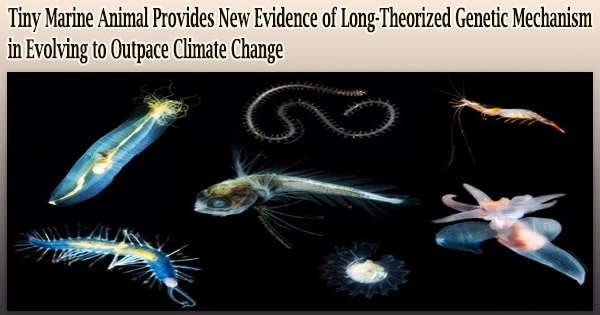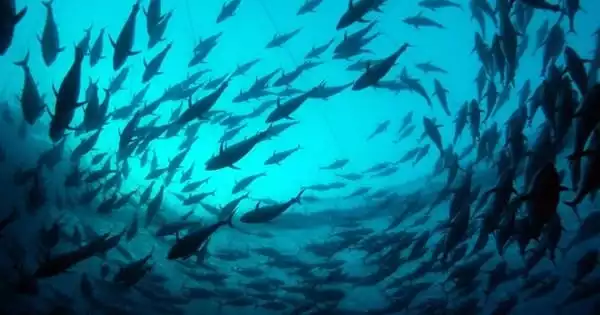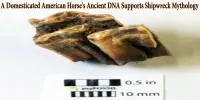According to recent research that answers a long-standing conundrum in the field of genetics, some copepods, tiny crustaceans with a disproportionately large position in the aquatic food chain, can adapt quickly enough to survive in the face of severe climate change.
The copepod Eurytemora affinis, which is only a millimeter long, is seen in great numbers paddling around the estuaries and seas’ coastal waters all over the world. It is typically eaten by young fish like salmon, herring, and anchovies.
“This is a dominant coastal species, serving as very abundant and highly nutritious fish food,” says Carol Eunmi Lee, professor in the University of Wisconsin-Madison’s Department of Integrative Biology and senior author of a new study on the copepods published in the journal Nature Communications. “But they’re vulnerable to climate change.”
Ocean salinity, Lee explains, is changing rapidly as ice melts and precipitation patterns change: “These copepods are a saltwater species that now needs to adapt to much fresher water in their environment.”
Many copepods (and innumerable other animals) evolved in salty water. As their environment changes, they will have to adjust to maintain their body chemistry … or die off.
“Salinity is a very strong environmental pressure in aquatic habitats,” says David Stern, lead author of the study and a former postdoctoral researcher in Lee’s lab, now working at the National Biodefense Analysis and Countermeasures Center.
In order to understand how some copepods reacted to that pressure, Lee, Stern, and the rest of the research group looked into it. They maintained a population of Eurytemora affinis, a tiny crustacean that lives in the Baltic Sea and reproduces over multiple generations, in their laboratory.
The copepods were then divided into 14 groups, each containing a few thousand. Four control groups participated in the trial in a setting similar to the Baltic. The other 10 groups experienced pressure similar to that brought on by climate change by lowering salt levels. For a total of 10 generations, each had their water salinity decreased to a lower level at each subsequent generation (this copepod’s generation lasted roughly three weeks).
In saltwater, there are a lot of ions, like sodium, that are essential for survival. But when you get to freshwater, these ions are precious. So, the copepods need to suck them up from the environment and hang on to them, and the ability to do that relies on these ion transporters that we found undergoing natural selection.
Professor Carol Eunmi Lee
To track evolutionary changes across the genomes of each line of copepods, the researchers next sequenced their genomes at the start of their experiment, again after six generations, and again after ten generations.
The regions of the genome thought to be crucial in regulating ions, such as sodium transporters, were where changes were greatest and most prevalent among the populations challenged by declining salinity.
“In saltwater, there are a lot of ions, like sodium, that are essential for survival. But when you get to freshwater, these ions are precious,” says Lee. “So, the copepods need to suck them up from the environment and hang on to them, and the ability to do that relies on these ion transporters that we found undergoing natural selection.”
At the conclusion of the study, the researchers discovered that copepods with specific genetic combinations of the ion transporter were more likely to persist over future generations even as the salinity of their water declined.
In fact, the fresher parts of the Baltic Sea frequently contain the identical gene variants, or alleles, that were discovered in the copepods that survived the salinity decline in the lab.
“With the number of genes we have encoding the traits in our copepods, there’s no way we would see the amount of parallelism we did unless something was driving it,” says Stern.
The evolution experiment provides fresh evidence for a genetic phenomenon known as positive epistasis, in which a gene variant’s beneficial effects are enhanced when they interact with other important genes.
Sewall Wright, a renowned genetics professor at the University of Wisconsin–Madison, and others promoted this hypothesis about a century ago as an alternative to additive evolution, which holds that the effects of numerous genes add up linearly and that each gene’s effect is equally important.
“Computer simulations of evolution in our experimental conditions predict that additive evolution would have given us much greater variation among our 10 lines,” adds Stern. “We didn’t see that kind of variation.”
Due to a lack of experimental tools, epistasis had largely gone untested, but thanks to modern sequencing techniques and computing simulations, it was possible to demonstrate positive epistasis at work in parallel evolution and to discuss the potential of genetics as a tool for studying climate change.
In the current study, Stern, Lee, and colleagues demonstrate how positive epistasis can promote sets of alleles repeatedly through natural selection, driving the parallel development of groups of animals.
“This copepod gives us an idea of what it takes, an idea of what the conditions are needed, that enable a population to evolve rapidly in response to climate change,” says Lee. “It also shows how important evolution is for understanding our changing planet and how or even whether populations and ecosystems will survive.”
















